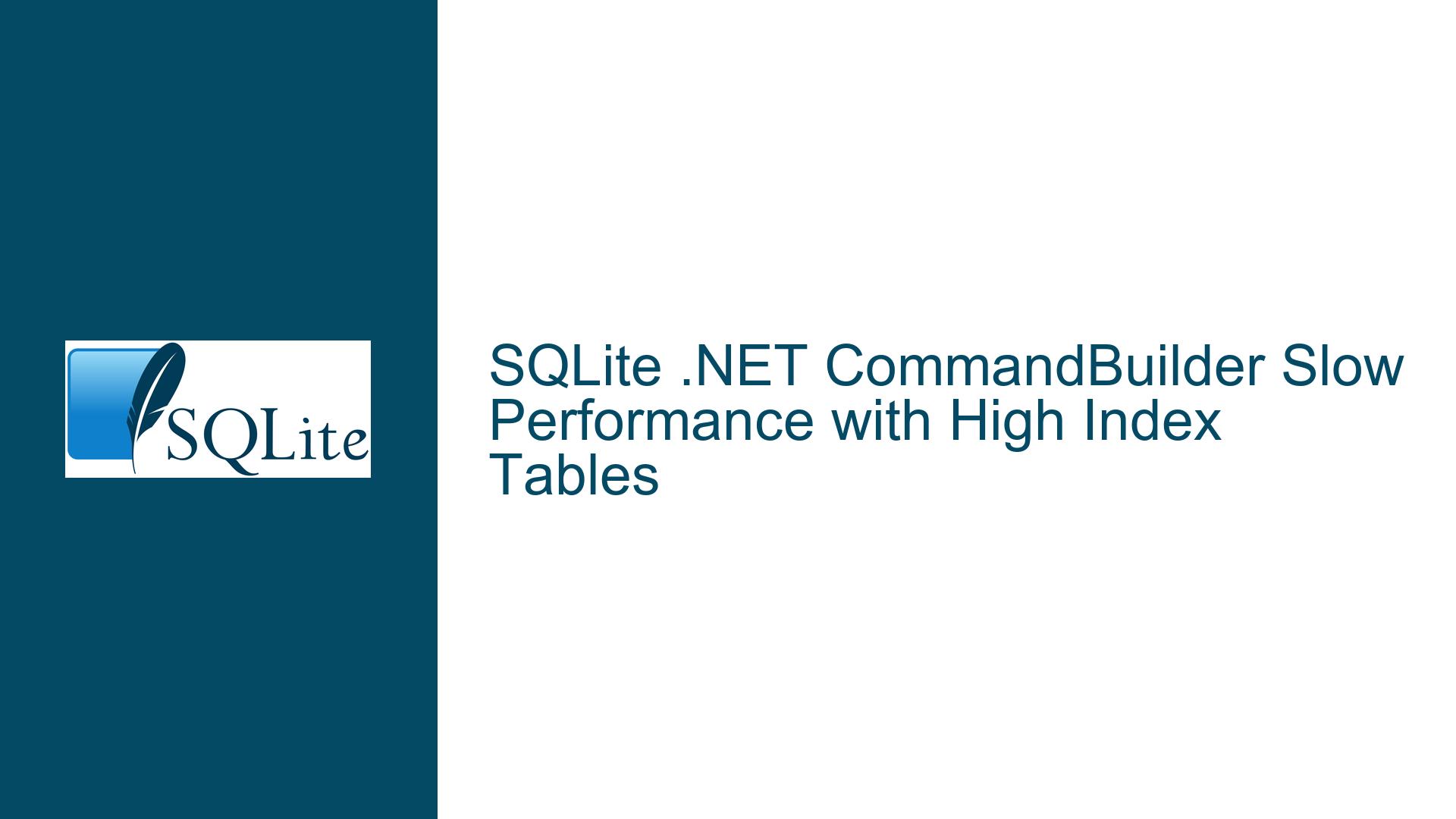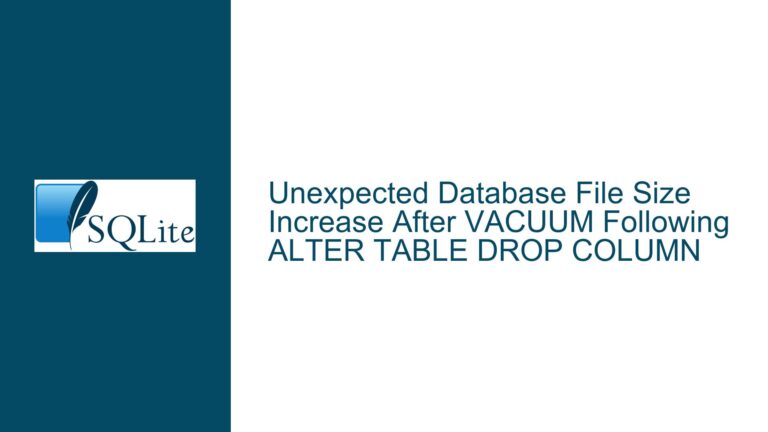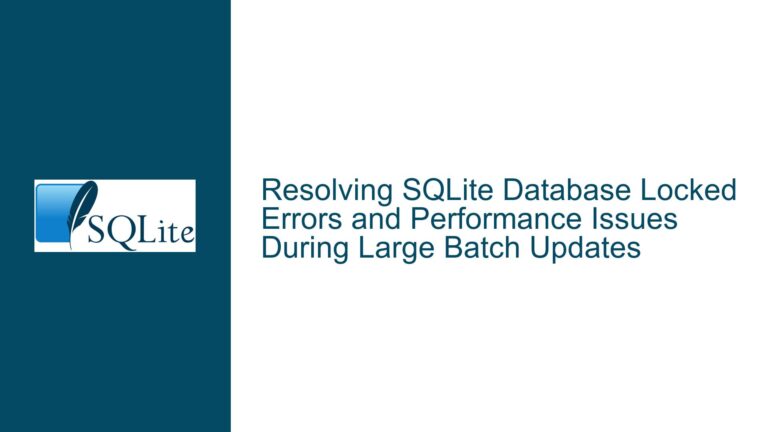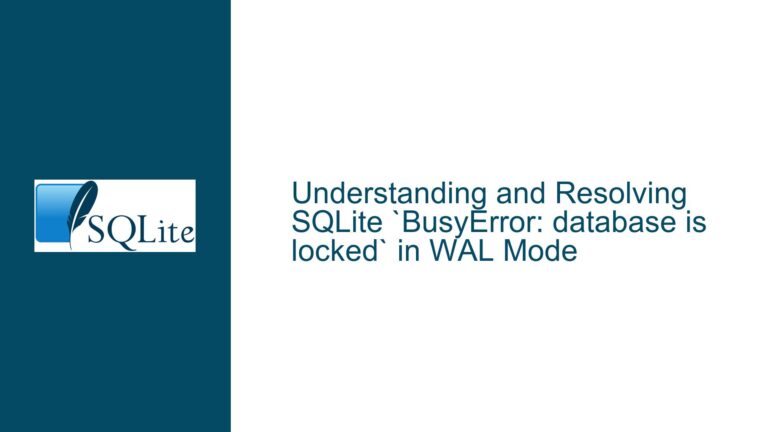SQLite .NET CommandBuilder Slow Performance with High Index Tables
Understanding SQLite .NET CommandBuilder Latency in Schema-Intensive Environments
Issue Overview: CommandBuilder Initialization Delays with High Index/Column Counts
The core problem revolves around the significant performance degradation observed when using the SQLiteCommandBuilder class (from the System.Data.SQLite .NET library) to auto-generate INSERT, UPDATE, and DELETE commands for tables containing hundreds of columns and indexes. In such scenarios, the first call to GetInsertCommand, GetUpdateCommand, or GetDeleteCommand can take 40–50 seconds even on empty tables. This latency scales linearly with the number of indexes and columns, indicating a systemic inefficiency in schema metadata retrieval.
Key Observations
- Empty Tables, Heavy Schema: The issue persists even when tables contain no data, ruling out query execution or I/O bottlenecks.
- Linear Scaling: Execution time increases proportionally with the number of indexes (e.g., halving the index count reduces latency by ~50%).
- Isolation to Schema Metadata Processing: The delay occurs during
SQLiteDataReader.GetSchemaTable()calls triggered by theCommandBuilder, not during database operations (e.g.,SELECT,INSERT). - Provider-Specific Behavior: The same schema performs optimally in the
sqlite3CLI or with other ADO.NET providers (e.g., SQL Server), confirming the bottleneck lies in theSystem.Data.SQLitelibrary’s implementation.
Technical Context
The CommandBuilder generates CRUD commands by inferring schema details (column names, primary keys, constraints) via GetSchemaTable(). This method queries SQLite’s internal schema metadata (e.g., sqlite_master, PRAGMA statements) to construct a DataTable describing the table’s structure. With hundreds of indexes, this process becomes computationally expensive due to iterative metadata fetching and redundant parsing.
Root Causes: Why High Index/Column Counts Cripple CommandBuilder Performance
Inefficient Index Metadata Enumeration
TheGetSchemaTable()implementation inSystem.Data.SQLiteissues multiplePRAGMAqueries (e.g.,PRAGMA index_list,PRAGMA index_info) for each index on the table. For a table with 100 indexes, this results in 100+ round-trips to the database engine, each parsing and returning metadata. These operations are not bulk-fetched or cached, leading to O(n) complexity relative to index count.Redundant Column Validation
Each column’s metadata (e.g., data type, primary key status) is validated against all indexes. For tables with 900+ columns, this results in O(n×m) operations (n = columns, m = indexes), exponentially increasing overhead.Unoptimized Reflection Overhead
The .NET library uses reflection to map SQLite’s schema metadata to ADO.NET’sDataTablestructures. Reflection-heavy code paths are notoriously slow in .NET when processing large datasets, and the library does not employ optimizations like compiled expressions or caching for schema metadata.Lack of Lazy Loading
TheCommandBuilderprecomputes all schema details upfront when generating the first command (e.g.,GetInsertCommand). This includes non-essential metadata for columns and indexes unrelated to the command being generated. For example,GetInsertCommanddoes not require index details but still triggers full schema resolution.Legacy Code Paths in System.Data.SQLite
The library’sCommandBuilderinherits fromDbCommandBuilder(part of .NET Framework’s base classes) and does not override inefficient methods for bulk metadata retrieval. Instead, it relies on default implementations that iterate through individual schema entities sequentially.
Resolving CommandBuilder Latency: Strategies and Workarounds
1. Bypass CommandBuilder Entirely
Manual Command Configuration
Instead of relying on CommandBuilder to auto-generate commands, define INSERT, UPDATE, and DELETE commands explicitly. This avoids schema metadata overhead entirely.
var insertCommand = new SQLiteCommand(
"INSERT INTO TestTable (ColumnPK, Column001, ...) VALUES (@pk, @c1, ...)",
connection
);
insertCommand.Parameters.Add("@pk", DbType.Int32, "ColumnPK");
// Repeat for other parameters
dataAdapter.InsertCommand = insertCommand;
Pros: Eliminates schema parsing.
Cons: Requires manual maintenance if the schema changes.
Stored SQL Templates
Store command texts in resource files or constants to avoid runtime generation.
2. Optimize Schema Retrieval
Override GetSchemaTable
Create a custom SQLiteDataReader subclass that optimizes schema fetching. Cache results of PRAGMA statements and reuse them across commands.
public class OptimizedSQLiteDataReader : SQLiteDataReader
{
private static ConcurrentDictionary<string, DataTable> _schemaCache = new();
public override DataTable GetSchemaTable()
{
string cacheKey = $"{CommandText}-{Connection.Database}";
if (!_schemaCache.TryGetValue(cacheKey, out DataTable schema))
{
schema = base.GetSchemaTable();
// Bulk-fetch all index metadata in one round-trip
FetchIndexesInBulk(schema);
_schemaCache.TryAdd(cacheKey, schema);
}
return schema;
}
}
Use PRAGMA Optimization
Fetch all index metadata in a single query instead of per-index PRAGMA calls:
SELECT * FROM sqlite_master WHERE type = 'index' AND tbl_name = 'TestTable';
Parse the sql field to extract index columns, reducing round-trips.
3. Schema Design Mitigations
Index Consolidation
Combine single-column indexes into multi-column indexes where possible. For example, replace:
CREATE INDEX TestTableIndex001 ON TestTable (Column001);
CREATE INDEX TestTableIndex002 ON TestTable (Column002);
With:
CREATE INDEX TestTableIndex_Composite ON TestTable (Column001, Column002);
Reduces the total index count, directly improving CommandBuilder performance.
Virtual Tables
For read-heavy scenarios, use SQLite’s virtual tables to expose a simplified schema view with fewer indexes.
4. Library-Specific Fixes
Upgrade to Microsoft.Data.Sqlite
Test with Microsoft.Data.Sqlite (maintained by Microsoft) instead of System.Data.SQLite. While it shares similar APIs, its CommandBuilder implementation might handle large schemas more efficiently.
Patch System.Data.SQLite
Modify the library’s source code to optimize schema retrieval:
- Replace iterative
PRAGMA index_list/index_infocalls with bulk metadata queries. - Cache
GetSchemaTable()results per connection/transaction. - Disable index metadata retrieval when unnecessary (e.g., for
INSERTcommands).
5. Asynchronous Initialization
Load the CommandBuilder asynchronously during application startup to avoid blocking the UI thread:
await Task.Run(() =>
{
using var cmdBuilder = new SQLiteCommandBuilder(adapter);
adapter.InsertCommand = cmdBuilder.GetInsertCommand();
});
6. Database Connection Pooling
Enable connection pooling to reuse schema metadata across sessions:
SQLiteConnectionStringBuilder csb = new()
{
DataSource = "TestDatabase.sdb",
Pooling = true,
CacheSize = 10000
};
7. Monitoring and Profiling
Use SQLite’s sqlite3_trace or .NET’s Stopwatch to identify slow queries:
SQLiteConnection.SetTraceCallback(query => Debug.WriteLine($"Executed: {query}"));
8. Alternative ORMs
Switch to micro-ORMs like Dapper or Entity Framework Core, which bypass CommandBuilder and allow raw SQL control.
Final Recommendations
- Immediate Fix: Replace
CommandBuilderwith hand-written commands. - Medium-Term: Migrate to
Microsoft.Data.Sqliteor implement schema caching. - Long-Term: Refactor the legacy schema to normalize tables and reduce indexes.
By addressing the metadata retrieval inefficiencies and adopting schema-conscious optimizations, the latency in CommandBuilder operations can be reduced from tens of seconds to milliseconds, even for extreme schemas.






